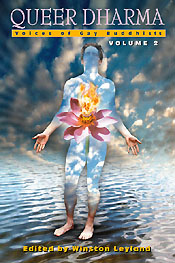| Excerpt from Queer Dharma, Volume 2 We Two Boys Forever Non-Clinging: Being Buddhist and Coupled Michael J. Sweet |
 |
|
Lenny and I had been together for three years when he went to live at the Buddhist monastery: he made no promise to return, and I felt devastated at losing the relationship that I had dreamed about since the dawning of my desires in puberty. We first met at one of the classic queer venues of the pre-Stonewall era, the fabled standees' line of the old Metropolitan Opera on Eighth Ave. I This didn't happen totally by chance; there was a go-between, my old high school friend Phil, a slightly closeted Irish Catholic, who had met this "interesting and acerbic Jew" at Fordham and thought that we would surely get along (he was more right than he imagined!). The meeting was like a thunderclap of good fortune-an attractive guy my age, brainy, witty, and musical; we hit it off immediately, and he invited me to visit him in farthest Rockaway to see his Oscar Wilde collection-this sounded very promising. I wasn't sure he was gay, nor did he know I was, but we immediately formed a very close friendship, spent all the time we could together. We whiled away the hours listening to Bach and Wagner, reciting Baudelaire and Swinburne, walking drunkenly through the city singing radical songs from the '30s, endlessly talking, and finally one fine spring morning falling into each other's arms with long suppressed desire. This was in the mid- 1960s, in an America still intensely homophobic, and with few openly gay couples in evidence to serve as role models. I knew there was a gay subculture in New York, but imagined it in unappealing terms-bitchy, swishy, superficial, and alcoholic, a stereotype that was probably at least partly based on some of the realities of that era, as depicted for example in the play and movie The Boys in the Band. A lot of my fear was based on deep doubts about my own attractiveness and worth, and meeting someone like Lenny, who seemed to like me, was like a wonderful fantasy come true.
[Article continued in book] |
|